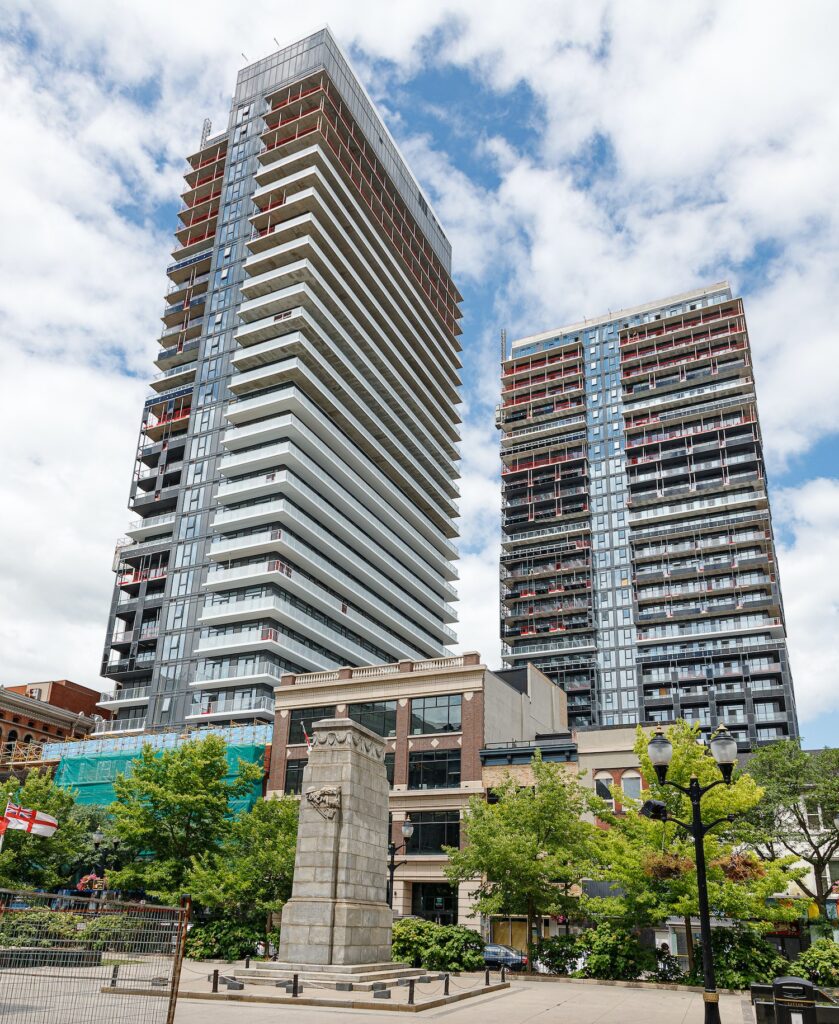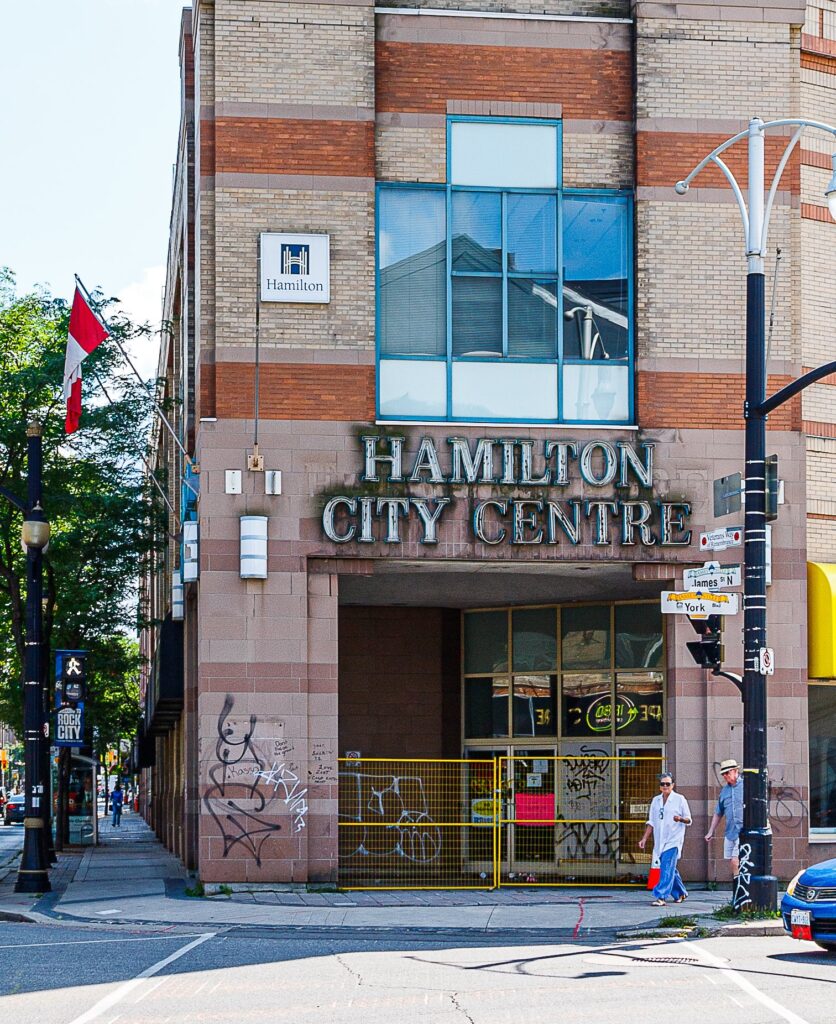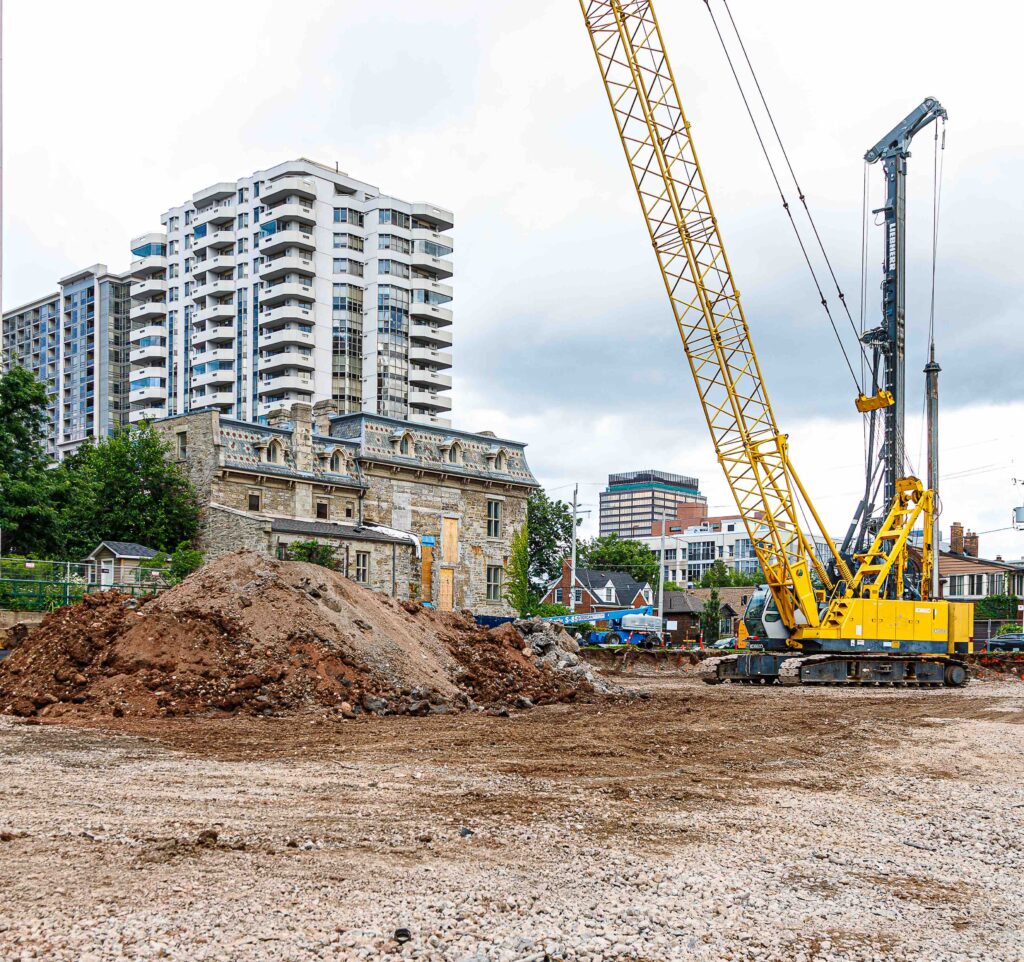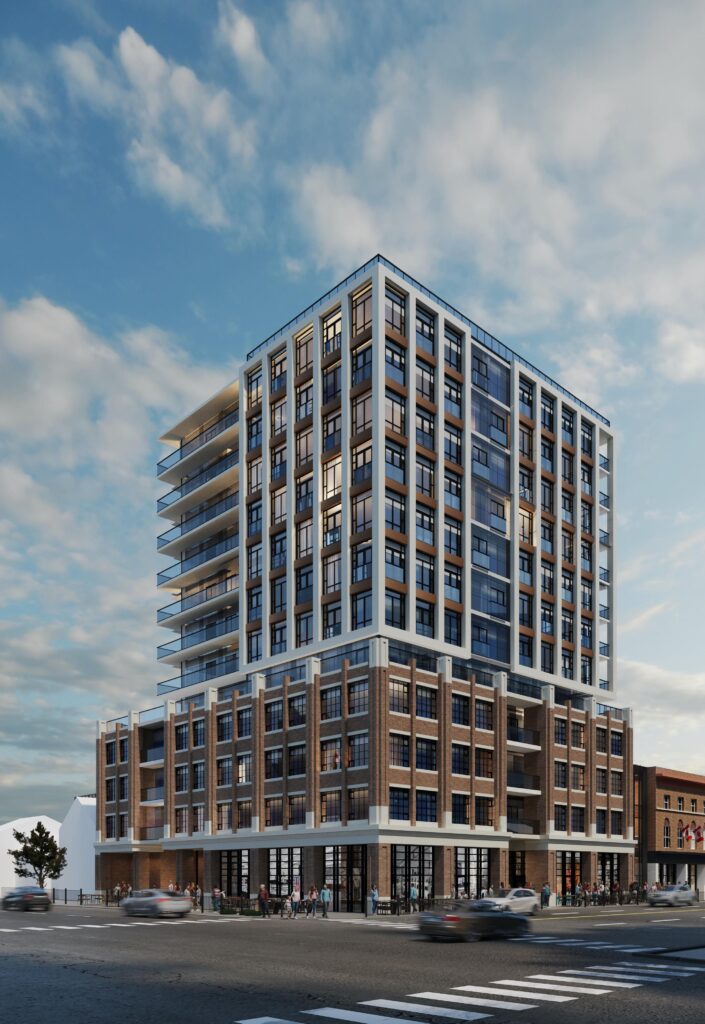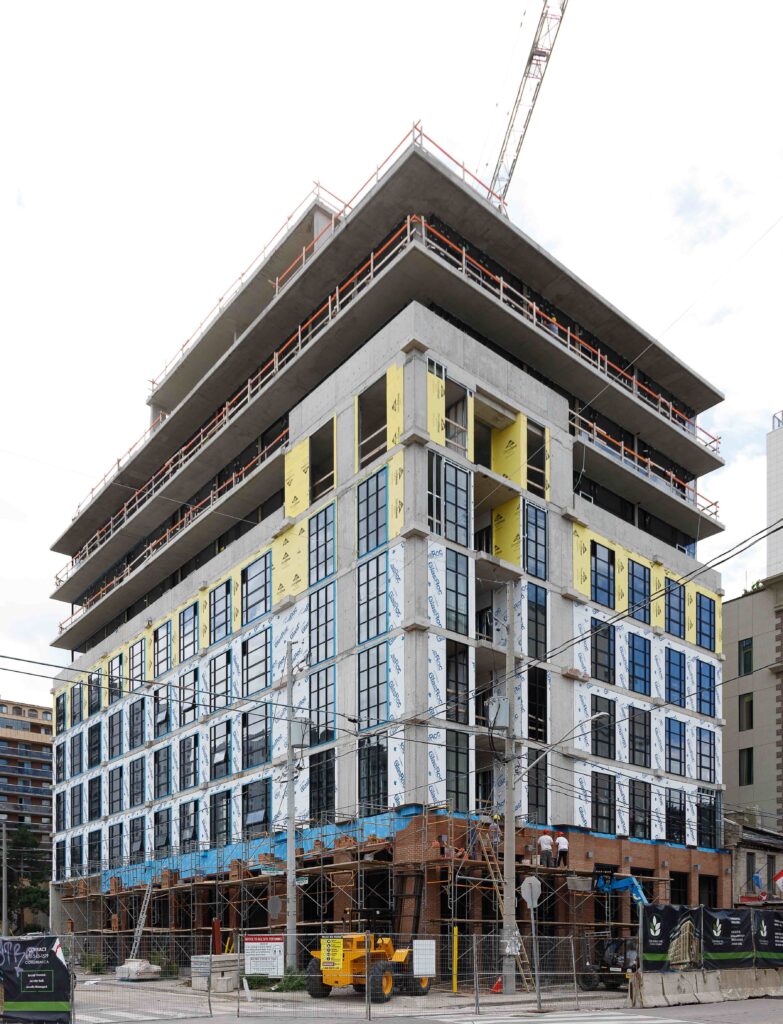Getting to the core
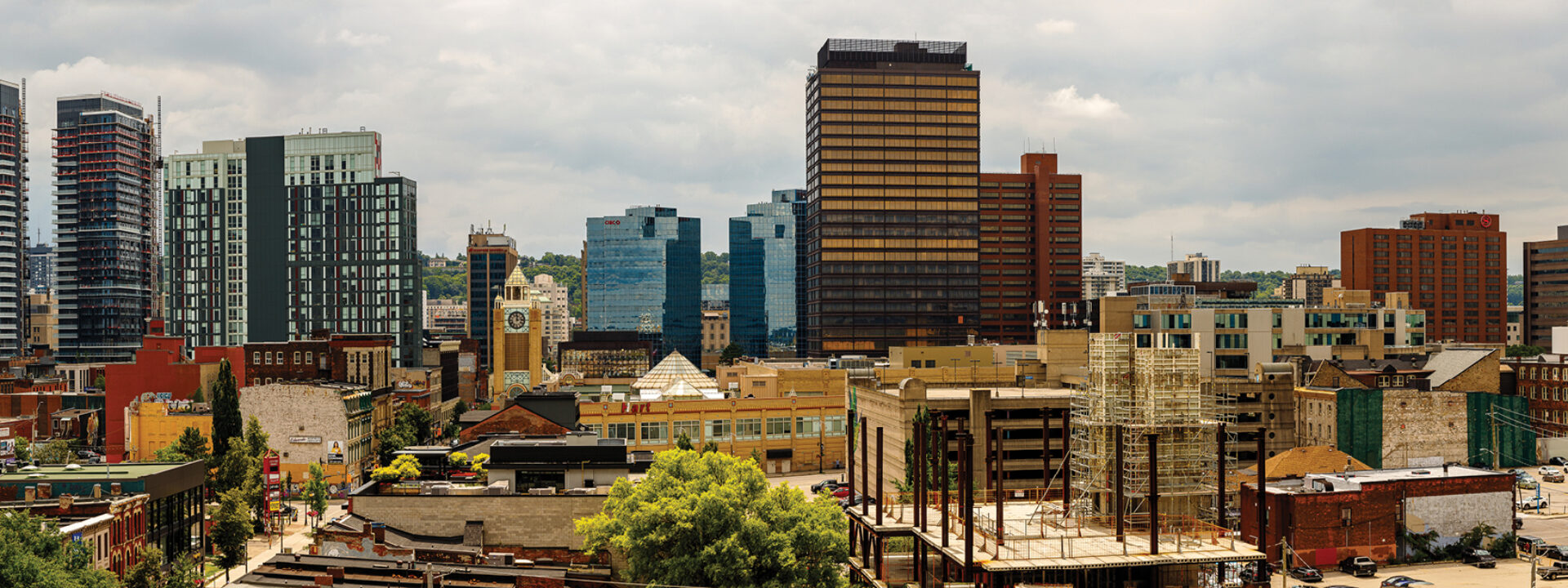
Thousands more people will be living in Hamilton’s downtown in coming years. This will change how downtowners live, work and play.
Hamilton’s downtown, long marked by abandoned storefronts and empty streets, is undergoing a rapid transformation. Construction cranes now dot the city’s skyline, reflecting a surge in residential development.
This will bring thousands of new residents to the core, creating jobs and economic opportunities while changing the culture and life of Hamilton’s downtown. But it will also create new pressure on the City to address the needs of its large vulnerable population, a situation made dramatically worse by the recent pandemic.
“We’re likely to have a whole lot more people living and shopping and eating and recreating in and around the downtown and that, inevitably, is a good thing,” says Terry Cooke, CEO of the Hamilton Community Foundation. He has been deeply engaged in the life of the city through philanthropy, politics, and business since the 1990s.
But his optimism is tempered by the realities of Hamilton’s growing street population.
“If the encampment, homelessness, addictions and mental health situation continues to worsen, and we don’t have an intentional plan to find dignified supportive housing for our most vulnerable, that will inevitably undermine the renewal and sense of safety, security and vibrancy. We’ve got to pay attention to that.”
Thousands are coming
The transformation is being led by a flood of residential high-rise construction in Hamilton’s downtown, defined in the city’s official development plan as bounded by Queen, Hunter, Victoria and Cannon streets, with narrow extensions along James to Charlton in the south and Stuart in the north.
About 4,000 new residential units have been added or are under construction in this areae core since 2017, according to the City of Hamilton’s economic development department. An additional 5,500 units are approved but have not yet broken ground, and 2,700 units are proposed, for a total of 12,200 units (including some units completed since 2017).
With an expected occupancy average of between 1.5 and about two2 people per unit, that means that 18,000 to more than 24,000 additional residents are expected to live in the core, increasing downtown Ward 2’s population from 37,000 in 2021 to up to 58,000 in coming years.
Some of the large projects already underway include the Cobalt Residences, two 30-storey towers nearing completion at King and Hughson; another 30-storey tower at King and Bay that will house a new McMaster graduate students residence; a 34-storey condo at 75 James St. S. and the 32-storey Television City project which has just broken ground at the former CHCH studios at 163 Jackson St. Over 2,300 units will be added with these projects alone.
This flood of new residents will more than make up for the decline in downtown office workers caused by increased remote work arrangements since the pandemic. Experts estimate foot traffic in Canadian cities is down about 20 per cent from before the pandemic. In Hamilton, which has an estimated 20,000 downtown office workers, this could mean as many as 4,000 fewer people in the core on any given workday.
Reports from some businesses suggest the decline in Hamilton is even steeper, with vendors at Jackson Square and the Hamilton Farmers’ Market complaining of slow weekday business.
In a recent article for Bloomberg, urban researcher Richard Florida, a professor at the University of Toronto School of Cities, said this is part of a larger trend in which central business districts “are the last vestige of the industrial age’s packing and stacking of knowledge workers.”
In an interview, Florida said this decline should not be a serious long-term problem for cities – like Hamilton – that are rebuilding their downtowns.
Young workers with the freedom to work from home will increasingly choose to live in downtown neighbourhoods because of their amenities, he said.
“They work from a café. Sometimes they work from a coffee shop. They will occasionally work from a co-working space, or from a library, or from a friend’s home.”
Urban planning researcher Markus Moos of the University of Waterloo has called this the “youthification” of downtowns.
But Florida said Hamilton’s downtown will attract other kinds of newcomers as well, including empty nesters seeking a downtown lifestyle. Hamilton’s relative affordability will also attract a large share of Canada’s international immigration, forecast to be nearly 500,000 annually in coming years.
And while Hamilton is often called a post-industrial city, Florida believes that new sustainable manufacturing will provide growing employment in Hamilton’s traditional industries, creating additional demand to live downtown.
“For Hamilton, the opportunity really is how do you create a super vibrant, exciting 24 by 7 live/work place downtown that’s a hub for its workforce but also for the remote workers who telecommute from Hamilton.”

Decades of decline
“Consider what makes a city centre magnetic, what can inject the gaiety, the wonder, the cheerful hurly-burly that make people want to come into the city and to linger there,” wrote urban activist and writer Jane Jacobs in her influential 1958 article “Downtown is for People.”
The article was Jacobs’ passionate defence of life in traditional and historic downtowns, and a manifesto against the prevailing 1950s ethos to saddle them with more and bigger highways and fortress-like convention centres, apartment buildings and commercial centres.
“These projects will not revitalize downtown; they will deaden it,” Jacobs predicted, we now know, correctly. “They banish the street. They banish its function. They banish its variety.”
Hamilton’s councillors and planners shared the prevailing mindset of the 1950s. In 1956, they imposed a one-way street system across the lower city to make it easier for industrial workers at the waterfront to commute to their homes in the suburbs. In the process, they devastated shopping districts on King, Main, James and John streets.
In the 1950s and ’60s, settlement shifted to the city’s growing suburbs, resulting in abandoned downtown storefronts, warehouses, and industrial buildings. Many neighbourhoods in Hamilton’s downtown became a refuge for low-income populations.
Buildings were destroyed to make way for parking to serve growing legions of office workers centred at King and James, creating a bustling downtown core during the day and an abandoned streetscape at night.
In 1972, Lloyd D. Jackson Square opened its first phase, creating a new shopping complex in the heart of downtown in a dramatic attempt to offer an alternative to the city’s growing suburban shopping malls. More than 43 acres of streets and Victorian buildings were levelled in the process.
The Eaton’s Centre (later renamed City Centre), built in 1990, was almost immediately troubled.
The City Centre is “the worst building in Hamilton,” writer Seema Narula wrote in an article on arts and culture in the city for British newspaper The Guardian in 2016.
“It’s an impenetrable fortress with few windows or opportunities to connect the inside and outside worlds together. Despite its desirable location it continues to suffer from low occupancy levels, leaving it eerily quiet.”
In a sign of things to come, IN8 Developments has proposed demolishing it to build four mixed-use towers (three 30 storeys tall and one 24 storeys) with outward-looking commercial space at ground level.
The complex, slated to create about more than 2,000 dwelling units, would be the largest downtown Hamilton construction project in 30 years.
Is gentrification inevitable?
The development industry has faced a growing chorus of criticism that accuses it of forcing up rents in downtown apartments and commercial spaces while taking previously cheap accommodation out of the market through renovictions (evictions generated by renovations).
In response, some developers are looking to create a new vision.
“If you approach it (development) in a positive way, it can be a net positive for the community,” says Steve Kulakowsky, CEO of Hamilton’s Core Urban Inc., which works exclusively in the downtown. “We’ve never renovicted anybody, and we try not to be labelled gentrifiers.”
Kulakowsky’s company has worked on a large array of projects focused on historic renewal and urban revitalization. But he’s particularly proud to be able to work with non-profit organizations working on homelessness issues.
In 2012, the company developed the Witton Lofts at 50 Murray St., building on the original McIlwraith School property, which was being used by Mission Services for shelter kitchen services. Core Urban found a better location for Mission Services and incorporated the historic school into a new condo building, a project that would have been impossible for a non-profit agency.
Core Urban completed a similar project with the Salvation Army and is working on another project at James and Barton streets again with Mission Services (see sidebar).
It’s a model that could be replicated by other development companies, such as the Hamilton Urban Precinct Entertainment Group (HUPEG), which is in discussions with the Salvation Army to move its men’s shelter on York Boulevard across the street from the planned refurbishment of the First Ontario Centre.
Creating a downtown for everyone
While developers are tackling problems of downtown gentrification, a new question is now being raised. As life gets more precarious for vulnerable street people, will central Hamilton continue to be a place where better-off people will want to live?
“At the end of the day, the purchasers of those condos are going to have to be confident that it’s a safe, liveable place where you want to spend your life,” says Cooke.
Cooke traces this problem to the de-institutionalization of psychiatric patients in the 1970s and ’80s, a situation severely exacerbated by both the opioid crisis and the pandemic.
He says the problem must be tackled on multiple fronts. Services for homeless people should be distributed and integrated into every neighbourhood. Housing affordability also needs to be urgently addressed.
“We better make sure that where there is land available, especially close to transit, or the LRT, that it is protected at the very least for mixed-income development, if not for deeply affordable units.”
He argues the provincial and federal governments must step up and be part of the housing solution. “Everywhere I’ve been, we are in a crisis situation in this country.”
There is no magic bullet for integrating Hamilton’s vulnerable population into our burgeoning downtown. But communities almost everywhere are facing similar problems, so Hamilton isn’t alone in this challenge.
Perhaps the way forward is to develop the strong citizen engagement that is part and parcel of the “cheerful hurly-burly” that Jane Jacobs said is the mark of a great community. This can grow as boarded up shops gradually re-open and people return to previously empty streets.
Kulakowsky of Core Urban thinks this will be the case. It starts with confronting the feeling that the downtown is an unsafe place.
“I think that (feeling) will be offset by getting some of those buildings that are in planning to materialize. Each one of those buildings will make a big difference to the vibrancy of the downtown. So I’m hopeful and feel positive because of that.”
Historic Coppley building to become community business hub
One of Hamilton’s iconic pre-Confederation buildings, the 1856 Coppley building at York and MacNab, is part of a bold redevelopment project that will turn the former suit manufacturing plant into a community business hub.
In a city with a wealth of historic buildings, the stone structure is a standout, considered by architects as one of the most important buildings in the city.
The Hamilton Community Foundation (HCF), purchased the 70,000-square-foot site two years ago together with TAS – a Toronto-based development company – and are in the process of renovating it.
HCF CEO Terry Cooke envisions the project as an office complex appealing to business owners who want to be located in a beautiful historically designated building. But he also believes it can be a hub for charities and community-based organizations that can be a catalyst for social and economic action.
The building contains two large courtyards, ideal for holding HCF educational or fundraising events, which could also be made available for civic events. The project will be developed in stages with initial leasing expected in 18 months and full completion in about five years.
Cooke also says the project could facilitate some novel social enterprise arrangements, such as charities taking an equity interest in the project in exchange for discounts on their rent.
“For us, part of it is investing in local real estate and the future of the downtown as an impact investment,” says Cooke. “And part of it is trying to be a catalyst for renewal and the importance of heritage architecture to the fabric of the downtown.”
Developer pioneers unique social partnership
Hamilton company Core Urban Inc. is forging a new model for development by working with a non-profit agency to provide desperately needed social housing while creating additional rental and commercial units for the market.
“We think that development can be used as a tool for good,” says Steve Kulakowsky, CEO of Core Urban, a local developer that only works in Hamilton’s downtown.
In its 15-year history the company has won numerous design, heritage and urban regeneration awards. Among its properties are the new apartment buildings at Augusta and James and the Templar Flats and Empire Times buildings on King William.
With the company’s latest project, it has swapped a building at 400 King St. E. (the former Canadian Red Cross building near Wellington Street) for two buildings owned by Mission Services at 325 James St. N., a men’s shelter with 58 emergency shelter beds and 12 transitional beds.
Core Urban renovated 400 King to Mission Services’ standards, increasing the privacy and dignity of its surroundings with the same number of emergency beds and expanding badly needed transitional beds from 12 to 52 (transitional beds include private rooms for up to a year for people looking for permanent housing).
Mission Services has moved into the new property and construction will begin soon on the office, commercial and rental project at James Street. The project will feature two structures – a 12-storey apartment building with 136 units – and a smaller office building. The plan is to put some commercial units in the ground floor, including a restaurant, cafe or grocery store with an estimated completion date in 2025.
Kulakowsky says he hopes the project will be an example of how developers can partner with social service agencies.
“We’re really proud of that project from all angles, because, from our opinion, it’s net benefit all the way around.”
Eugene Ellmen writes on sustainable business and finance. He lives in downtown Hamilton.








